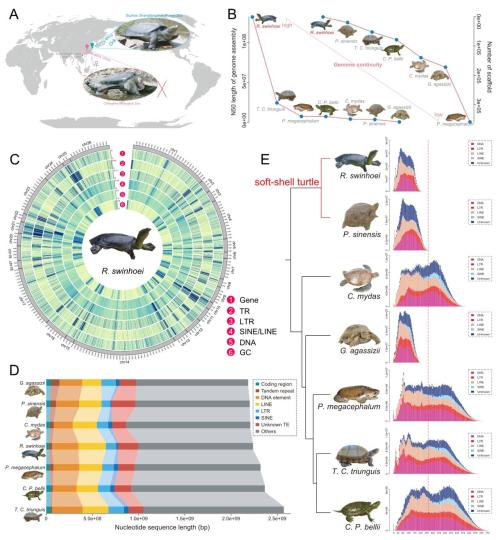Kunming, May 12 (Reporter Hu Yuanhang) reporter learned from the Kunming Institute of Zoology of the Chinese Academy of Sciences on the 12th that the institute and the Changsha Ecological Zoo cooperated to successfully assemble the high-quality reference genome sequence of the world's most endangered turtle and turtle species, and analyzed its adaptive evolutionary basis. The researchers found that the turtle was closely related to the Chinese turtle, but began to part ways 54.4 million years ago.

The picture shows the assembly and comparative analysis of the genome of the spotted turtle. Courtesy of Kunming Institute of Zoology, Chinese Academy of Sciences
The spotted turtle is currently the largest surviving turtle species on Earth, with a dorsal carapace length of up to 1.5 meters and a weight of up to 115 kilograms. In addition, the spotted turtle is currently the most endangered turtle species in the world. At the beginning of 2019, only 4 individual turtles have been clearly recorded worldwide (1 female and 1 male in China; 2 in Vietnam, gender unknown). However, on April 13, 2019, the unexpected death of a female individual in China (which was the only female spotted turtle in the world at that time to determine its sex) was very regrettable.
In order to avoid the permanent loss of genetic information in the female turtle's genome, and in order to promote the investigation and protection of the turtle, with the support of changsha ecological zoo, researchers collected tissue samples of the individual during the pathological anatomy examination of the female dead turtle. By combining relevant sequencing data, the researchers successfully assembled a high-quality reference genome sequence at the chromosome level of the individual.
The picture shows the genetic differences behind the similar body size of turtles and tortoises. Courtesy of Kunming Institute of Zoology, Chinese Academy of Sciences
Based on a variety of datasets and algorithms for building phylogenetic trees, the researchers found that the turtle was closely related to the Chinese turtle, but began to part ways 54.4 million years ago. Population history analysis showed that the effective population of the spotted turtle showed a continuous downward trend historically, which is consistent with its low genetic heterozygosity and genetic diversity. Comparative genomics analysis shows that some of the core genes associated with autophagy, DNA damage response, and growth-related processes are undergoing positive selection or rapid evolution, suggesting that they have important functions in processes such as the long lifespan and large size of the spotted turtle. In addition, the researchers found that some genes associated with tooth formation are missing in the turtle genome, which partly explains the genetic basis of their toothless phenotype.
The picture shows the population status of the spotted turtle. Courtesy of Kunming Institute of Zoology, Chinese Academy of Sciences
The analysis and analysis of the whole genome genetic information of the spotted turtle not only retains the whole genome information for the species (especially the ZW heterozygomic genetic information of the female turtle), but also has great significance for the field investigation, search and protection of the spotted turtle in the future.
The relevant research results were published in the international journal Molecular Ecology Resources. (End)
Source: China News Network